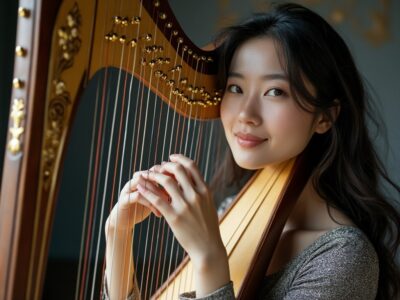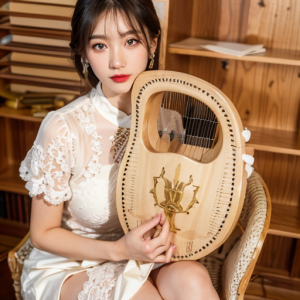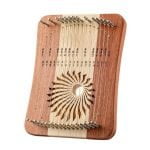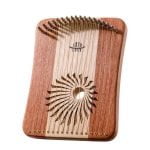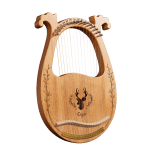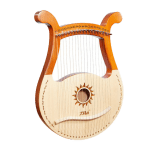The lyre harp, with its beautiful curving shape and melodious sound, has seen a resurgence in popularity over the last few years. More and more people are being drawn to learn this elegant instrument. However, as a beginner starting out, the variety of lyre harp options available can feel overwhelming. With sizes ranging from tiny to taller than a person and prices from $20 to $2000, how do you decide what is the best fit for you? This blog post will guide you through the key factors to consider when picking your first lyre harp.

Lyre Harp Sizes
Lyre harps come in a range of sizes, from small 7-string lap harps to larger 22-string floor harps. For a beginner, a good place to start is with a 16-22 string lap harp. These mid-size harps are large enough to produce a rich tone, yet still very portable. The added strings will allow you to play more complex and dynamic songs too. Smaller harps often don’t have the depth of tone or range that a larger harp can produce. However, if you plan to travel a lot, a more compact 10-12 string lap harp may suit your needs better.
Consider your body size as well when choosing a harp size. You want one that you can comfortably reach all the strings without straining. The harp shouldn’t be so large that you can’t hold it properly. Getting the ergonomics right will make playing much more enjoyable.
Construction Material
Lyre harps mainly come in two types – wood or plastic. Wood harps are generally considered better quality, producing a warmer, richer tone. However, they also come with a higher price tag. If you are just starting out, a plastic lyre harp is usually perfectly adequate. Look for one made from ABS plastic rather than the cheaper PVC, as ABS plastic will produce a better sound.
Some harps combine both wood and plastic, using wood for the arms and plastic for the body. This gives you some of the tonal benefits of wood at a more affordable price.
No matter the main material, try to choose a harp with solid construction. Check product reviews to see if any buyers had issues with parts breaking or joints coming loose. The harp should feel sturdy and well put together.

Number of Strings
As mentioned earlier, the number of strings on a lyre harp can range from 7 up to 22. For beginners, 16-22 nylon or gut strings give you versatility as you learn. Steel strings have a brighter sound, but may be harder on the fingers for new players. Nylon/gut strings have a softer, mellower tone.
Having more strings allows you to play songs in different keys and experiment with a wider range of notes. You don’t have to use all the strings at first, but it’s handy having those options as your skills progress.
Included Accessories
Look for a harp that comes ready to play out of the box. It should include any needed tools for tuning, extra strings and an instruction book or online video lessons. Some also come with useful extras like a tuning key, songbook and carrying case.
Accessories will vary, so check what is included before purchasing. Buying a harp with everything you need saves you sourcing and paying for all those add-ons separately later.

Acoustic or Electric
Will you play your harp acoustically or want to plug it into an amplifier? Acoustic harps project their sound naturally through the hollow body and soundboard. Electric harps have pickups to amplify the vibrations of the strings electronically.
Electric harps cost a bit more, but give you flexibility to play live or with headphones. The electric sound is different though, so test it out first if you can. If you’ll mainly play at home alone, an acoustic harp may suit your needs fine.
Extra Decorative Elements
Many lyre harps come adorned with ornate carvings, inlays or painting. This is purely decorative and doesn’t affect the sound. However, a beautifully detailed harp can inspire you to pick it up and practice more. Find a harp whose style and decorations appeal to your own artistic tastes.
Brands
There are a number of good lyre harp brands producing quality instruments for beginners. Top choices include Roosebeck, Rees Harps, Mid-East and Musicmakers. Each will have their own sound character and price points. Read reviews of specific models, rather than going by brand name alone.
Ask fellow players for recommendations of brands or models that have worked well for them too. This can give you confidence in choosing your harp.

Set Your Budget
What price range are you comfortable with? Lyre harps can cost anywhere from $40 for basic starter models to over $2000 for large floor harps. Realistically, as a beginner you don’t need to spend huge amounts to get started.
Set a maximum budget before you start looking. Expect to spend $150 to $350 for a good quality, beginner-friendly 16-22 string lap harp. Remember to factor in shipping costs too. Also set aside some room in your budget for accessories like books or lessons.
Try Before You Buy
If possible, test out a few different harp models in person before purchasing. Music stores often have some available to play. Pay attention to sound quality, string tension, size, weight and comfort as you try them out. This hands-on experience will confirm which size and style suits you best.
If you can’t access harps locally, many online retailers accept returns within a short window. Buy from a store with a good returns policy, so you can ship it back if the harp you choose doesn’t live up to expectations.
Choosing your first lyre harp is an exciting first step on your musical journey. Keep these key factors in mind as you search for the ideal instrument. With so many options available, take your time exploring before deciding. The right beginner harp will hopefully delight you with many years of magical music making. Let the buying process be fun and play some melodies in the process. Your new harp is waiting!


